YOUR AIRBOX, FRIEND OR FOE?
Separate the Fact from the Fiction
By Lonn Peterson/Thunder Products Inc
There is a very common belief that getting rid of all the restriction from the air box is about the best thing you can do. Wow! Just think of all the horsepower, and it's practically free. Isn't it strange then, that all the manufacturers build model after model, year after year with those restrictive air boxes? Don't they read the same magazines we do? If they did, they would certainly learn about all of the ways to get rid of all that nasty old restriction, right?
Maybe not. Let's look at the physics of how fuel enters your intake system. The atmospheric pressure exerts force on the fuel in your float bowl, forcing it through your jetting circuits, into the air stream passing through your carburetor. In order for this process to work, the internal pressure in your carburetor must be lower than atmospheric. Pretty simple. If you have removed your air box, cut a number of holes in it or are running without a lid, you may be in for a surprise. Your internal pressure is now nearly the same as atmospheric, making fuel delivery difficult.
Engineers call the difference in pressure a pressure drop differential. A particular amount of restriction (some call it vacuum) provided by your air box keeps the internal pressure lower than atmospheric, insuring consistent fuel delivery over a wide range of temperatures and altitude. Without an acceptable pressure drop differential, the
Engine will be fussy about changes in jetting to maintain performance.
Another aspect that affects pressure drop is air speed (velocity). Simply put, the higher the air velocity in the carburetor, the lower the internal pressure. When you attempt to operate with a wide open air box or with the lid off, the air velocity is actually slower (yes slower) due to the enlargement of the intake opening. You now have plenty of air; however you also have poor air velocity. Velocity is needed to atomize the fuel and produce quick throttle response. This slower air speed promotes higher internal pressures, closer to atmospheric, hindering fuel delivery.
Yes, it is possible to get an increase in performance by running with an open air box or even removing the air box. This may be OK if you always ride at the same temperature and altitude, say Southern California for example. However, if you are dealing with temperature and altitude changes, expect to lose horsepower and performance unless you are a jetting whiz. The same jetting set up is not right for everyone or everywhere. Temperature, altitude, air density, atmospheric pressure, fuel density, Engine pressure drop and humidity are all part of the total equation for air/fuel delivery. This is why it is important to have adjustability of air as well as fuel.
Is the factory air box restrictive? Yes, it is usually somewhat restrictive. To insure optimum performance, it is necessary to arrive at the correct amount of pressure drop (restriction) that works for your riding requirements. This always requires some experimentation. Rather than drilling holes, cutting holes, and taping or gluing holes shut, there is an easier and more scientific method. There is a product called a TPI Valve (Total Performance Intake) costing $19.95. The TPI Valve looks like a small picture frame with a slide door that opens or closes the frame. There is an air filter built into the TPI Valve. You cut approximately a 2" x 2" hole in your air box, usually in the lid. Install the TPI Valve. Now you can regulate the size of the opening, controlling the pressure drop and air speed of your air box. This allows you to quickly and easily determine the right amount of opening by trying a number of different openings in a matter of minutes. You may find your machine runs best at 1/4, 1/2, 3/4 or maybe full open. The amount of opening in your TPI Valve will give you the equivalent of one to three main jet sizes depending on how restrictive your air box is. We call this "air jetting". The correct amount of opening can be judged by the machine's performance. Good performance from zero to top end indicates the proper amount of opening. You can also return to a totally stock air box by closing the TPI Valve. This is handy for very wet, muddy or sandy conditions.
Before you run out and spend all of your hard earned dollars on some super intake system that gets rid of all the restriction and claims to make tons of horsepower, you may want to ask a few questions.
After discussing the air portion of the intake system, we feel compelled to at least mention the fuel side of the system. The ability to tune an Engine to perfection depends on being able to regulate fuel and air. The Dial-A-Jet automatic fuel induction system is a completely adjustable external jetting system that delivers maximum horsepower to any Engine at any temperature or altitude. Dial-A-Jet improves throttle response and fuel efficiency. It works well with stock or modified engines, standard or high-performance air boxes and exhaust systems. Easy to install kits are available for snowmobiles, ATV's, dirt bikes and motorcycles.
http://www.thunderproducts.com/AirboxArticle.htm





